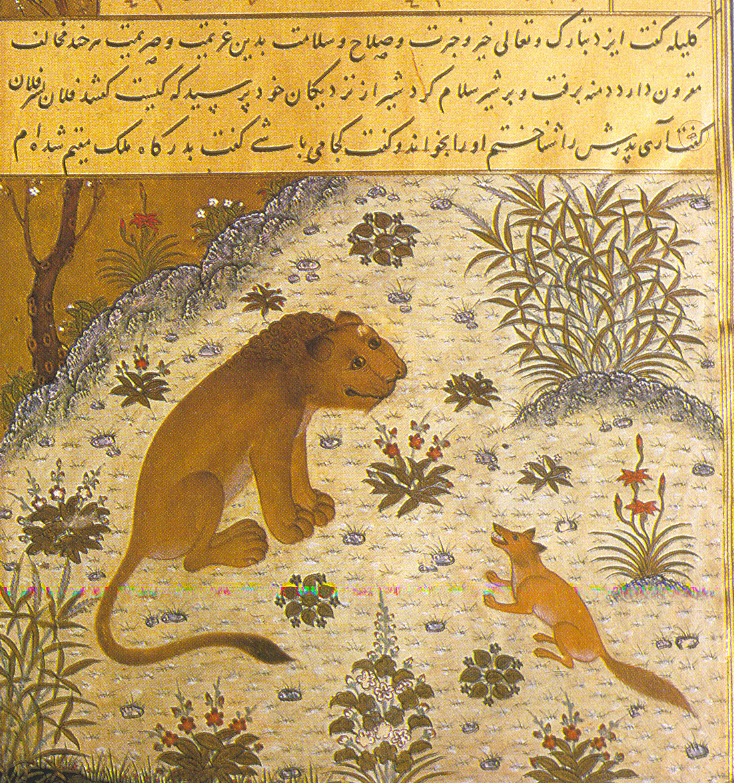Vishnu Sharma on:
[Wikipedia]
[Google]
[Amazon]
 Vishnu Sharma (
Vishnu Sharma (
 Vishnu Sharma (
Vishnu Sharma (Sanskrit
Sanskrit (; stem form ; nominal singular , ,) is a classical language belonging to the Indo-Aryan languages, Indo-Aryan branch of the Indo-European languages. It arose in northwest South Asia after its predecessor languages had Trans-cultural ...
: विष्णुशर्मन् / विष्णुशर्मा) was an Indian scholar and author who wrote the ''Panchatantra
The ''Panchatantra'' ( IAST: Pañcatantra, ISO: Pañcatantra, , "Five Treatises") is an ancient Indian collection of interrelated animal fables in Sanskrit verse and prose, arranged within a frame story.
'', a collection of fables.
Works
Panchatantra is one of the most widely translated non-religious books in history. The ''Panchatantra'' was translated into Middle Persian/ Pahlavi in 570 CE by Borzūya and intoArabic
Arabic (, , or , ) is a Central Semitic languages, Central Semitic language of the Afroasiatic languages, Afroasiatic language family spoken primarily in the Arab world. The International Organization for Standardization (ISO) assigns lang ...
in 750 CE by Persian scholar Abdullah Ibn al-Muqaffa as ''Kalīlah wa Dimnah'' (). In Baghdad, the translation commissioned by Al-Mansur
Abū Jaʿfar ʿAbd Allāh ibn Muḥammad al-Manṣūr (; ; 714 – 6 October 775) usually known simply as by his laqab al-Manṣūr () was the second Abbasid caliph, reigning from 754 to 775 succeeding his brother al-Saffah (). He is known ...
, the second Abbasid Caliph, is claimed to have become "''second only to the Qu'ran in popularity.''" "''As early as the eleventh century this work reached Europe, and before 1600 it existed in Greek, Latin
Latin ( or ) is a classical language belonging to the Italic languages, Italic branch of the Indo-European languages. Latin was originally spoken by the Latins (Italic tribe), Latins in Latium (now known as Lazio), the lower Tiber area aroun ...
, Spanish, Italian, German, English, Old Slavonic, Czech, and perhaps other Slavonic languages. Its range has extended from Java
Java is one of the Greater Sunda Islands in Indonesia. It is bordered by the Indian Ocean to the south and the Java Sea (a part of Pacific Ocean) to the north. With a population of 156.9 million people (including Madura) in mid 2024, proje ...
to Iceland
Iceland is a Nordic countries, Nordic island country between the Atlantic Ocean, North Atlantic and Arctic Oceans, on the Mid-Atlantic Ridge between North America and Europe. It is culturally and politically linked with Europe and is the regi ...
.''" In France, "''at least eleven Panchatantra tales are included in the work of Jean de La Fontaine
Jean de La Fontaine (, ; ; 8 July 162113 April 1695) was a French Fable, fabulist and one of the most widely read French poets of the 17th century. He is known above all for his ''La Fontaine's Fables, Fables'', which provided a model for subs ...
''."
Legend
The prelude to the ''Panchatantra'' identifies Vishnu Sharma as the author of the work. Since there is no other independent external evidence about him, "it is impossible to say whether he was the historical author . . .or is himself a literary invention". Based on analysis of various Indian recensions and the geographical features and animals described in the stories,Kashmir
Kashmir ( or ) is the Northwestern Indian subcontinent, northernmost geographical region of the Indian subcontinent. Until the mid-19th century, the term ''Kashmir'' denoted only the Kashmir Valley between the Great Himalayas and the Pir P ...
is suggested to be his birthplace by various scholars.
He has also been associated with the University of Taxila.
The prelude narrates the story of how Vishnu Sharma supposedly created the ''Panchatantra''. There was a king called Sudarshan who ruled a kingdom, whose capital was a city called Mahilaropya (महिलारोप्य), whose location on the current map of India is unknown. The king had three sons named Bahushakti, Ugrashakti and Anantshakti. Though the king himself was both a scholar and a powerful ruler, his sons were "''all dullards''." The king despaired of his three princes' inability to learn, and approached his ministers for counsel. They presented him with conflicting advice, but the words of one, called Sumati, rang true to the king. He said that the sciences, politics and diplomacy were limitless disciplines that took a lifetime to master formally. Instead of teaching the princes scriptures and texts, they should somehow be taught the wisdom inherent in them, and the aged scholar Vishnu Sharma was the man to do it.
Vishnu Sharma was invited to the court, where the king offered him a hundred land grants if he could teach the princes. Vishnu Sharma declined the promised award, saying he did not sell knowledge for money, but accepted the task of making the princes wise to the ways of politics and leadership within six months. Vishnu Sharma knew that he could never instruct these three students through conventional means. He had to employ a less orthodox way, and that was to tell a succession of animal fables – one weaving into another – that imparted to them the wisdom they required to succeed their father. Adapting stories that had been told for thousands of years in India, panchatantra was composed into an entertaining five part work to communicate the essence of diplomacy, relationships, politics and administration to the princes. These five discourses — titled "The Loss of Friends", "The Winning of Friends", "Of Crows and Owls", "Loss of Gains" and "Imprudence" — became the ''Panchatantra'', meaning the five (''pancha'') treatises (''tantra'').
References
External links
* * {{DEFAULTSORT:Vishnusharma Panchatantra Ancient Indian writers Indian fabulists Indian male writers Indian Sanskrit scholars Asian people whose existence is disputed Year of birth missing Year of death missing Taxila Tehsil